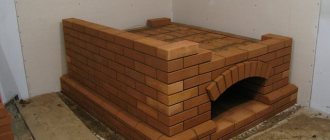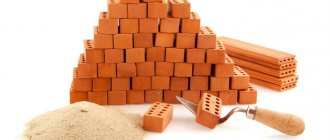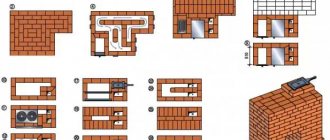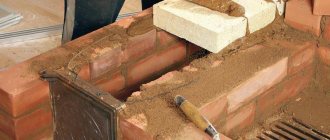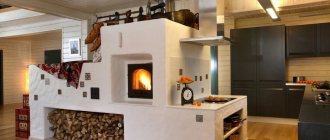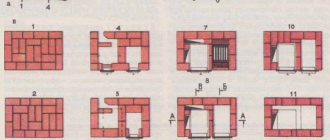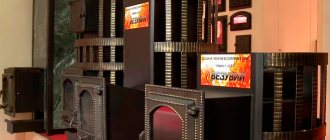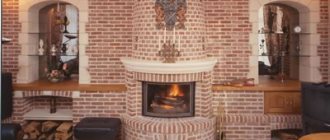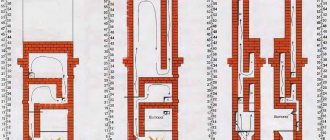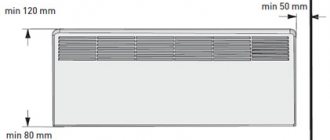Tube furnace type
Tubular furnaces of type B are radiant-convection, narrow-chamber, with an upper flue gas outlet and vertical coil pipes.
The convection chambers are rectangular in shape. The radiant chambers are combined in a common housing. They are manufactured in six standard sizes. Tubular furnaces of type G are radiant-convection, narrow-chamber, with an upper exhaust of flue gases. They are produced in two versions: GS - vertical flare combustion of fuel and GN - volumetric flat combustion of fuel with two radiation chambers.
Tubular furnaces of type C are cylindrical, with a vertical arrangement of radiant chamber pipes and an upper flue gas outlet. Available in two versions: CS - with one radiation chamber and flare combustion of liquid and gaseous fuel, without a convection chamber and with a convection chamber; CL - with several radiation chambers and a convection chamber, with flat combustion of liquid and gaseous fuel.
Tubular furnaces of type B are radiant-convection, narrow-chamber with flameless combustion of fuel, bottom exhaust of flue gases and horizontal arrangement of coil pipes.
Tubular furnaces of the GS and GN type with a horizontal pipe arrangement and an upper exhaust of flue gases operate on gas or liquid fuel; they are used: for heating to temperatures not exceeding 500 C; if the number of threads for one furnace can be taken as two or four; if a horizontal arrangement of pipes is required for natural descent of the product.
Tube furnaces of the SUOL type are designed for heating reaction tubes when calcining substances in a flow of any gas. Split and one-piece ovens are manufactured. They are a ceramic tube with a wound filament coil, enclosed in another ceramic tube. The space between this pipe and the metal casing is filled with thermal insulating material.
Tubular furnaces of the GS and GN type with a horizontal pipe arrangement and an upper exhaust of flue gases operate on gas or liquid fuel; they are used: for heating to temperatures not exceeding 500 C; if the number of threads for one furnace can be taken as two or four; if a horizontal arrangement of pipes is required for natural descent of the product.
Tubular furnaces of the TsS and TsD types are cylindrical with a vertical arrangement of pipes and an upper exhaust of flue gases and are adapted to operate on gas-oil fuel. Tube furnaces of these types are more appropriate to use if a short heating time and higher heat intensity are required, low heating capacity and if there is a need for several independently controlled flows.
A tubular furnace of a vertical sectional type, consisting of two sections, each of which has a radiant and convection chamber. In the convection part there is a gas heating coil for blowing into the stabilization column. The furnaces are heated using hydrocarbon gas produced in the process.
In tubular furnaces of the radiant-convective type, 60 - 80% of the total heat is transferred in the radiant chamber, and the remaining 40 - 20% in the convective chamber.
Calculate the reaction coil of a gradient-type tubular furnace (Fig. 3.1) for the pyrolysis of the propane fraction, the composition of which is given in table. 3.1. The composition of pyrolysis products (pyrolysis gas) is also given in Table. 3.1 [4, p. Pyrolysis of the propane fraction is carried out with the addition of Z 2000 kg/h (20 wt.% of the raw material) water vapor.
The process takes place in tubular furnaces of the heating-reaction type with radiating furnace walls.
The porcelain tube is heated in an electric tube furnace type TK-30/200 with silit heating elements.
Gasoline pyrolysis, the main technological process for the production of olefins, occurs in gradient-type tube furnaces. In these furnaces, gasoline mixed with water vapor is fed into several parallel-operating pyroelectric coils heated by flameless combustion burners. In pyrocoils a mixture of products of thermal decomposition of gasoline is formed, the target of which are lower olefins: ethylene and propylene. The yields of target products are usually maintained in practice by stabilizing the process parameters: the temperature of the pyro-gas at the outlet of the pyro-coil, the consumption of gasoline and water vapor.
Types of blast furnaces and their characteristics
| The blast furnace body includes brickwork, an outer steel casing and a support structure that determines the type of furnace In an American type kiln, the weight of the top loading device is supported by the outer steel shaft casing and support columns. Compared to other types of furnaces, less steel materials are used here. However, in American-type furnaces, vibration in the upper part of the furnace spreads to the entire furnace body. In this regard, when the shaft masonry wears out, i.e., when its thickness decreases, an emergency situation may occur. In Japan, blast furnaces of this type are no longer built after the Second World War. The German type b furnace is a free-standing structure in which the steaming device is supported by a separately installed tower-type frame. In this case, the steel body is not subject to load. In a blast furnace of this design, it is easy to check and repair tuyeres, tapholes and slag outlets. However, the weight of the shaft brickwork is directly transferred to the tuyere section. This area is believed to be under a lot of stress.” The design of the mixed type b furnace avoids the disadvantages inherent in type a and b furnaces. In this case, the design of the blast furnace is free-standing, the support is a tower-type frame, the columns of which, supporting the top, are moved away from the furnace at a distance of up to 10 m. Machines for opening cast iron tapholes and jib cranes are suspended from the columns. Console-shelf TYPE KO" structure e is a slightly modified type b. Here the shafts are supported by brackets and a support ring mounted on the middle step of the outer tower frame. With this design, it is possible to easily check and repair tuyeres, ch1; gun tap hole, slag outlet. |
Specifics of using the solution
How to determine the consistency of the solution
Before installing the stove yourself, you need to decide on the type of solution. In the construction of heating products the following are used:
- Lime or cement paste - the viscosity of the composition depends on the specifics of the soil. For soil with low moisture levels, a lime or lime-cement mixture is suitable. Cement is used on wet soils.
- Clay-sand mortar - for the body and smoke circuits.
- Fireclay sand mixed with refractory clay - for lining. The thickness of the seam should be minimal.
- Ready-made mixtures - stones are laid on fireclay or clay-sand compositions.
- Lime or cement-lime mortar - for binding the components of the stove in the attic.
- Cement paste - for the outer surface of the pipe.
When making your own fireclay mixture, take into account the fat content of the clay and select proportions from 1:0 to 1:3.
Oven type
This type of furnace is especially interesting for the metallurgical industry. Under other names, they are also used in the production of ceramics and, in some cases, in the production of glass.
This type of stove uses indirect heating. The flame develops tangentially between the furnace wall and the crucible. The burner is located on the outside of the oven.
This type of oven, most suitable for France, is a vertical steel cylinder with a heat-resistant inner insulation that acts as a vessel.
This type of stove comes in two main versions.
This type of stove has fireboxes with grates. The volume of the furnace for every 100 kg of fuel burned in 1 hour is equal to: for hard coal 0 25 - 0 29 m3, for brown coal 0 43 - 0 50 m3; per 1 m2 of grate area, 100 - 200 kg of coal is burned in 1 hour.
What types of furnaces are used for firing pyrites.
The type of furnace is selected depending on the scale of production, the weight, shape and size of the parts to be soldered, the required productivity, the cost of the equipment, the cost of its operation and maintenance.
Some types of furnaces have their own specific stopping procedures, which are discussed in the corresponding operating instructions.
This type of furnace is most widely used in the production of various electrode products, especially anode mass. These furnaces have high productivity, require few operating personnel, and allow automation of the entire calcination process. The disadvantages include the highest percentage of carbon combustion compared to stoves of other designs.
This type of furnace can be recommended for serial and large-scale production workshops. It combines the versatility inherent in chamber elevator furnaces, the high-speed heating mode due to the low load layer inherent in pusher furnaces, and reduced warping of castings. The productivity of the furnace depends on the annealing mode.
This type of furnace appeared in 1903. Coal loaded into vertical retorts produces gas of better quality.
This type of furnace currently represents the technically most advanced tube furnace used in the chemical and petroleum refining industries. For furnaces with double-sided heating of pipes, it is characteristic that the pipes of the radiation section are exposed to irradiation from both sides. Both long-flame and flameless burners can be used for heating. The design of the furnace, of course, must be adapted to the selected type of burners.
Glossary of furnace terms
The storage capacity of a stove is the absorption and accumulation of heat by the stove during combustion and its gradual release to the outside. The active height of the stove is the vertical distance from the grate or the bottom of the lower smoke channel to the upper plane of the ceiling (thickness up to 140 mm) or to its lower plane (thickness more than 140 mm).
Ram - fireplace smoke damper-turntable. Bypass is a small window (hole) in the rear or side wall of the firebox to create draft in the stove during kindling. Concrete is an artificial stone material obtained by mixing cement (10-15% of the total mass) with fillers (sand, gravel, crushed stone). By changing the strength, density and thermal conductivity, it can be given a wide variety of properties and shapes. In the stove industry it is used for constructing foundations, prefabricated household stoves and floors.
Broken stove - this is what in the old days they called a monolithic stove, built on the basis of a thick solution of clay and sand, packed into formwork. Hog - a horizontal chimney to a chimney, often installed in attics. A “potbelly stove” is a non-heat-intensive metal stove made from scrap materials. It was widely used at the beginning of the last century. It was used to heat houses, warehouses and retail premises, dugouts, barracks, and railway cars. Often used on construction sites for drying rooms. There are “potbelly stoves” of various forms of factory production.
Water absorption is the negative property of a material to absorb and retain moisture. Materials saturated with water lose their strength and increase thermal conductivity. For example, the strength of a brick saturated with moisture is only 75% of the strength of a dry brick. Otter - a brick lining on the chimney at the junction with the roof, preventing snow from penetrating into the attic. This is the expansion of a brick pipe with masonry above the roof, in order to prevent rainwater from flowing through the pipe into possible cracks in the places where the pipe adjoins the roof, i.e. the water will flow down the “otter” and fall onto the roof, bypassing the junction of the pipe and the roofing material.
Gzhel brick is a brick made from refractory clay. The greatest strength and fire resistance is possessed by “gerbil” clay, which contains large quantities of fine quartz sand impurities. There are no alkalis in this clay. Brick made from refractory clay is white and smooth, has great strength and increased fire resistance, which allows it to be used for lining the inner surface of a firebox for firewood.
Clay is the remains of weathered rocks. Consists of tiny particles resembling scales. In nature it is found with admixtures of sand, mica, and lime. If the content of impurities is insignificant, the clay is called fatty, high - lean (oily clay contains no more than 2-3% sand, medium - about 15%, and lean - about 30%). When laying stoves, clay is used as a binder. Gzhel clay is used for laying the walls of the firebox and fire channels made from Gzhel or refractory bricks.
Dutch - this name is firmly rooted in the vocabulary of the stove maker; obviously, this type of stove has proven itself over time and cannot be erased from human memory, even though real Dutch stoves are no longer made. The Dutch woman served people faithfully and left behind the myth that she continues to exist. Nowadays, a stove with a heating shield is most often called a Dutch oven. It is simpler to build and has a number of positive qualities in its design that are not indifferent to both the one who builds it and the one who will use it. This type of stove requires less brick for its construction than, say, a Swedish stove, and fewer stove appliances. The crucible is the main element of the Russian stove, where fuel is burned and food is prepared, covered with a brick vault.
A deflector is a device whose operation is based on the phenomenon of suction of flue gases with the help of wind.
Firewood is the most common type of solid fuel for stoves and kitchen fires. The calorific value of firewood depends on its moisture content and density. Dry firewood made from heavy wood produces a higher temperature when burned. For example, birch firewood provides 20-25% more heat than aspen firewood.
Dushnik is a stove device designed to connect internal air ducts with a heated room. “Smoke tooth” is one of the structural elements of the fireplace between the firebox and the smoke collector. Designed to eliminate differences in air flow that cause smoke in the fireplace and penetration of soot into the room.
Zapechek is the free space between the stove and the wall in a heated room. Damper - a shield in a Russian stove for closing the mouth of the furnace. The ash pan is located under the grate and serves to collect ash and remnants of unburned fuel particles. It closes with a “blower” or “ash” one. Wind support zone is a space limited by the roof and structures protruding above it and a conventional plane drawn at an angle of 45 degrees. to the horizon from the top of the protruding structure. To eliminate the wind pressure blocking the exit of smoke from the pipe, the pipe should be extended so that its mouth rises beyond the wind pressure zone. Lime is a hydraulic binder obtained by burning limestone in shaft kilns. Initially, quicklime (lumpy or boiling lime) is formed. When interacting with water, it “boils”, i.e. is extinguished, crumbling into small parts, actively releasing heat and increasing in volume. The resulting lime is called slaked lime. It is part of the cement-lime mortars necessary for laying chimneys and constructing foundations and preparing complex solutions for plastering stoves. It is recommended to keep slaked lime for 2-3 weeks before use. Radiation is the process of transferring heat in the form of radiant energy from burning fuel and hot gases to the internal surfaces of the firebox and smoke channels. Tiles are tiles made of baked clay (tiles) for lining stoves. On the front side the tile is covered with glaze, on the other side it has a fastening system with the oven wall. Coal is a compound of carbon and hydrogen. Has a very high calorific value. Closed fireplaces are fireplaces in which the combustion chamber and chimney are mounted in the wall. Open fireplaces are fireplaces that are independent of walls and partitions and are usually installed in the center of the room. The outlet for hot gases is a metal cap over the firebox, open on all sides. Semi-open fireplaces are fireplaces that are attached to the wall, so the firebox and chimneys operate independently. Frame is a spatial lattice system consisting of elements that carry the load directed towards the structure. Frame stoves are stoves with a metal frame. Ceramic brick is the main material for laying stoves; made from clay by plastic or semi-dry pressing. Standard dimensions are 250x120x65 mm. The weight of one brick is 3.5-3.8 kg. Brick is fired in continuous ring and tunnel kilns. Clay begins to sinter at a temperature of 800-1000 degrees. C. Its individual particles melt and bind the mass into a whole. At temperatures above 1000 degrees. When the clay melts, the result is burnt brick, which is difficult to peel off, absorbs little water and therefore weakly binds to the solution. This type of brick is not suitable for laying stoves.
A well is the old name for a vertical channel in the smoke circulation of a furnace.
The grate is a lattice cast iron or steel flooring between the ash pit and the firebox. Solid fuel burns on it. It serves to supply air to support combustion. The cap is a metal probe with beveled planes. It is installed above the pipe in order to protect the stove from blowing out and moisture. Convection is a phenomenon that occurs when moving gases come into contact with the walls of smoke channels. Furnace efficiency factor (efficiency) is the ratio of the amount of useful heat (entered into the room) to the amount of heat expended (planned, subject to complete combustion of the fuel). Let's say the stove gave out 24,000 kcal per day, and the heat contained in the fuel was 34,000 kcal. In this case, the efficiency of the stove is 0.7 (24,000: 34,000 = 0.7). The stove could not release all the heat contained in the fuel, because some of it went into the chimney with hot gases, some remained in the fuel and ash that fell into the ash chamber, plus inevitable losses due to incomplete combustion of the fuel. The lounger is a horizontal brick chimney in the attic. Previously, they were placed on a wooden floor, which often led to fire accidents. The sun lounger is prohibited by modern fire safety standards.
Summer flow - direct flow from the firebox into the pipe. Used to ignite the stove. Spoon - placing the brick flat and along the wall, laying with a log, spoon. Frost resistance is the ability of a water-saturated material to withstand repeated alternating freezing and thawing without visible signs of destruction and without a significant decrease in strength. Frost resistance is expressed by the number of cycles (about 15-20) of freezing and thawing carried out in laboratory conditions. For example, brick and mortar for chimneys must have their own specific frost resistance. Top-mounted furnaces are furnaces of the upper floors, which are built on the furnaces of the lower floors and have a common foundation. Fire resistance is the property of a material to withstand high temperatures and direct exposure to fire without collapsing, changing shape or losing strength. Individual parts of furnaces are exposed to different temperatures, so bricks with different fire resistance are used in the furnace business. Fireclay brick can withstand temperatures up to 1600 degrees. C, They line and line the fuel chambers. Refractory brick can withstand temperatures of 900-1000 degrees. C. It can be used to construct fireboxes for furnaces where wood and peat are burned. Fireclay bricks are made by firing fireclay, a powder made from fired and ground fireclay. The dimensions of this brick are 230x113x65 or 250x123x65 mm. It is used mainly for the lining of boiler furnaces, kitchen hearths and heating stoves. The cap is the top part of the chimney. Retreating - the space between the stove and the wall (cold quarter) to protect wooden structures from fire. Hearth is a collective name for all kinds of stoves, fireplaces, stoves. The pass wall is a part of the stove (stove) structure, installed between the combustion chamber and the first smoke channel or inside the combustion chamber, where hot gases rise to a cast-iron stove or other ceiling for more complete heat transfer. The transfer hose is a horizontal smoke channel connecting the furnace outlet channel with the main or wall pipe. The furnace roof is the upper wall of the furnace that covers all gas ducts. Usually done in two or three rows of brickwork. If there is a mounted pipe, a hole of at least 130x130 mm is made in the ceiling for the exit of flue gases. Sand is a natural material used to prepare clay-sand mortar. Sand in furnace work for mortars must be fine-grained (grain size no more than 1 mm). With larger grains it is not possible to achieve thin seams, which reduces the strength of the masonry. Heater stoves are stoves used to heat a room. Hot air enters the rooms through short air ducts coming from the stove. Periodic heater stoves are stoves that have massive brickwork and a significant volume of stones, which protects the outer walls from overheating and retains heat for a long time. The stone backfill is heated by an open fire in the lower part to 1000 degrees. C, and at the top - up to 500 degrees. C. At such temperatures, the soot burns completely. If the stones are separated from the flue gases by a stove, then it can be used both in continuous and periodic mode. Constant (long-term) heater stoves are stoves that have a minimum wall thickness and a minimum volume of stone backfill. The temperature of the stones reaches 300-350 degrees. C. When using gaseous or liquid fuel, it is regulated by the amount of fuel supplied, and when using electricity - by changing the current strength. Such ovens must be equipped with automatic equipment that turns off or reduces the power when the temperature rises above normal. The advantage of these stoves is that the stones are separated from the flue gases by an iron plate, which allows the stove to be heated during bathing procedures. Heating stoves are stoves that serve only for heating a room. Heating and cooking stoves are stoves used both for space heating and for cooking, baking bread, i.e. combined action ovens.
LDH furnaces are bell-type furnaces, where the principle of free movement of gases is implemented. A well-known promoter of such stoves is I. O. Kuznetsov. Special-purpose stoves are stoves designed to perform special functions: sauna stoves, dryers for clothes and shoes, stoves for heating building materials, for heating garages, greenhouses, etc. Furnace tools are tools used for furnace work:
A pick hammer consists of a steel head mounted on a wooden handle. On one side of the head there is a blunt striker, on the other there is a pointed spatula. Used for chopping and chopping bricks, cutting tiles, breaking old brickwork.
The trowel is intended for rubbing, leveling and trimming mortar protruding from the seams.
The rule replaces the stove maker’s ruler and serves to check the accuracy of the masonry.
An iron shovel is used to prepare a solution and remove debris.
A wooden shovel is necessary when mixing clay mortar.
The building level is designed to check the horizontality of the rows and the correctness of the masonry.
Tsiklya is a knife for chopping and trimming tiles.
The square is used to control the correct laying of corners.
A plumb line is a thread with a weight used to check the verticality of the masonry. In modern furnace construction, the tools used have become much more numerous, as customer requirements and the level of furnace construction have increased. Stove appliances are metal products that are used to equip heating stoves and kitchen hearths. Furnace appliances include: doors and half-doors, views and smoke valves, rotary dampers, cast iron stoves, grates, etc.
Doors and half-doors are divided into combustion, blower, cleanout and view doors. The best material for making stove doors is cast iron. Doors made of cast iron do not warp, do not rust, and close the openings tightly. Fuel is loaded through the combustion door.
The blower door is designed to regulate the air supply.
The cleaning door closes the opening used to clean the smoke ducts. Views are opened and closed through the view half-door. Furnace views and smoke valves are used to close the chimney at the end of the firebox and regulate the furnace draft.
The view is a cast iron frame with a hole covered by a “blink” or a lid (baking tray). The dimensions of the views along the frame opening in the light are 120, 180 and 220 mm. Weight from 1.9 to 4.3 kg.
The valve consists of a cast iron frame and a cast iron slider that moves in grooves. The dimensions of the valve openings are from 130x130 to 260x240 mm.
The rotary damper (gate) is designed to close the chimney. The diameter of butterfly valves is from 152 to 230 mm, weight is from 2.7 to 4.2 kg.
The top cast iron deck is a solid plate with one or two holes covered by burners, or from several standard cast iron plates that are used to equip the stoves.
Grate grates are used to ensure uniform air supply to the layer of burning fuel. Different sizes of grates are made for different types of fuel.
Ovens (ovens) are made of roofing steel. Size; cabinets depend on the size of the oven. The most common oven size is 450x400x350 mm.
Water heating boxes are made of galvanized steel. The optimal size of the water heating box is 400x190x420 mm. Pechurka is a small niche designed for storing household utensils in a Russian stove. OPT stove is a heating rectangular thick-walled stove. Plasticity is the ability of a material under load to significantly change shape and size without the formation of cracks, ruptures and other deformations. When laying stoves, it is very important to have a solution of good plasticity.
Under is a platform in the crucible of a Russian stove or in the firebox of a fireplace on which firewood is burned. Hearth brick - made from refractory or ordinary clay and has dimensions of 225x225x70 mm. They are used to line the bottoms of bakery ovens. Due to the reduction of seams, the bottom of this brick is more even than that of ceramic or refractory bricks. The base of the foundation is the lower plane resting directly on the ground. Podpeche - the space between the foundation and the lower arch that supports the Russian stove. It is arranged in order to save materials, as well as for storing firewood, equipment, etc.
Podtopok is a firebox located below the hearth of a Russian stove.
Polati is a wooden flooring of a Russian stove that increases the area of the stove bench.
Porsok is a nook in a Russian oven. Typically a pit at the bottom of a furnace for storing smoldering coals. Portland cement is a hydraulic binder obtained by finely grinding clinker and gypsum together. Clinker is formed by firing a raw mixture of limestone and clay before sintering.
Burnout is a special hole in the internal brickwork to improve the primary draft of the furnace. The recommended cross-section is no more than ¼ brick. Strength is the ability of a material to resist destruction when exposed to external forces that cause deformation and internal stress in the material. Strength is determined by the highest stress causing destruction of the material. This value is called tensile strength and is expressed in pascals (Pa). To characterize the strength, materials such as brick, concrete, cement, and mortars are marked. For example, a brick grade of “100” means that it collapses under a load of 100 MPa. The grade of material is determined in laboratories.
Cutting a pipe is a thickening of the wall of a furnace or smoke channel (pipe) at the point of contact with the building structure made of flammable material. Pipe fluffing is an expansion of the pipe walls in the form of an overlap of bricks at the joints with the floors. It is carried out to thicken the pipe wall, in order to minimize the temperature of the pipe in places of contact with wooden structures, for fire safety. A solution is a mixture of binders and a fastening agent diluted with water. When laying brick kilns, clay, lime or cement mortars are used, the purpose of which is to bind individual bricks and concrete blocks into a single strong foundation and monolithic kiln body. Clay mortar in furnace work is used mainly when laying the furnaces themselves and chimneys, since it can withstand temperatures up to 1000 degrees. C. The amount of sand included in it depends on the fat content of the clay. Lime mortar is used for laying foundations and chimneys above the roof. As a rule, a lime-sand mortar is used, composed in proportions of 1:2 or 1:3.
Cement mortar provides the strongest and fastest-hardening connection, so it is necessary when laying foundations and chimney caps. Mixed mortars are used in cases where lime mortars are not strong enough and cannot withstand heavy loads on the masonry. Along with cement-lime mortars, cement-clay mortars are also used in the kiln business. Clay improves plasticity, increases water-holding capacity and density of the solution. Rumpa is a box with holes designed to connect the tiles to each other and the brickwork. Heat capacity is the property of a material to absorb heat when heated, and to release it when cooled. The indicator is specific heat capacity. Heat-dissipating surface of the furnace:
1. The surface of the walls within the active height of the furnace, “washed” on one side by air, and on the other by flue gases or in contact with hot fuel; 2. Roof with a furnace height of no more than 2 m; 3. The surface of the walls of the heating chambers. Heat transfer in furnaces is the process of transfer of heat from flue gases to the outer surfaces of the furnace due to convection, radiation, and thermal conductivity. The heat-absorbing surface of the stove is the inner surface of the firebox and smoke channels, washed by flames or hot gases. The surfaces are not the same in terms of the degree of heat absorption: the walls of the firebox absorb heat more intensely than the walls of the smoke channels. Thermal conductivity is the property of a material to transfer heat. The calorific value of fuel is the amount of heat released when burning 1 kg of solid or 1 cubic meter. m of gaseous fuel. The calorific value of each type of fuel depends on its combustible components, as well as on ash content and humidity. The main combustible components include carbon, hydrogen and volatile combustible sulfur. Carbon in its pure form is a black solid, hydrogen is a flammable, colorless, odorless gas. The fuel also contains oxygen, nitrogen and minerals, which form ash and slag after combustion. The fuel also contains water, which, together with minerals and nitrogen, does not take part in combustion and constitutes the so-called fuel ballast. Peat is the remains of rotted plant matter. In its chemical composition and calorific value it is close to firewood, but has a higher ash content.
The poke is the smallest edge of the brick in terms of area. Specific heat capacity is the amount of heat required to heat 1 kg of material by one degree. Specific heat capacity is designated by the letter C and expressed in joules (J = kg • deg.). The mouth is the narrowest hole in a Russian stove, which is covered with arched masonry. Through the mouth, fuel is poured into the fire chamber and cast iron pots and bowls are placed. A weather vane is a device that changes its position under the influence of wind. Necessary to protect the chimney from blowing out. Lining is a protective lining of 1/2 or 1/4 thick fireclay brick on the inner surface of the firebox, protecting the walls and roof from exposure to high temperatures. If the heat transfer of the furnace with any type of fuel does not exceed 3000 kcal/h (3490 W), then the lining can be made with a thickness of 1/4 brick. If it exceeds, then the lining is made of 1/2 brick. The lining is carried out without ligation with the main masonry of the outer walls of the furnace.
Hailo is the opening where smoke enters the chimney. The fireplace has the shape of a truncated pyramid, the bottom of which corresponds to the area of the firebox, and the top to the cross-section of the chimney. Bread chamber is a space in a heating oven for cooking food. There are “white” and “gray” with passing fire. Household stoves are a type of stoves that are used in the household: heating water, steaming livestock feed, drying vegetables and fruits, etc. Cement is a binder. It is used in the manufacture of foundations for stoves and pipes, when laying out pipe heads, as well as for laying main pipes in houses with a height of more than one floor. The cement begins to set no earlier than after 45 minutes and after 12 hours it is completely fixed. Cement includes all varieties of Portland cement, slag Portland cement, pozzolanic Portland cement and aluminous cement.
Swedish - 1) Heating and cooking stove, the distinctive feature of which is a cooking chamber, in the lower part of which a cast-iron stove is placed above the firebox. 2) The name “Swedish” means a heating stove with a kitchen hearth built into it. In this case, the furnace, as a rule, has a “summer” and “winter” operation. The chimney neck is the part of the chimney that projects above the roof between the otter and the cap. Shestok is a brick platform located in front of the mouth of the thermal chamber of the Russian furnace.
What does the oven consist of?
Today, even stove designs are developed by designers, so the appearance can be completely different, but the internal components are difficult to replace with anything
Pay attention to this section; after studying it in detail, you will already half know how to build a stove with your own hands
Firebox
She's a heat exchanger. It is the main part of any heating structure. Heating oil is loaded into it, and ignition and combustion take place there. The size of the firebox is directly proportional to the area of the house that needs to be heated. The minimum side size of a square heat exchanger is 40 cm, the maximum rarely exceeds 1 meter. Laying the heart of the stove with your own hands is only possible if you have refractory bricks - constant strong heating will cause ordinary building materials to crack. The thickness of the walls should be equal to half the brick.
Brick kiln firebox
Ash pan
This is part of the structure, which in the stove diagram is located at the very bottom under the heat exchanger. It is necessary for collecting waste combustion materials; it is often combined with a compartment for air supply. This is not to say that this is a mistake, but it can spread stove debris throughout the house. Many furnace designs include a special tube for supplying oxygen, so the diagrams show one door leading to the ash pit.
Chimney
Before you build the stove with your own hands, think about how you plan to remove the soot, because installing a chimney requires partial disassembly of the roof and its subsequent sealing. Some craftsmen use corrugated pipes instead of a brick chimney, similar in appearance to pipes from old hoods. Such materials are not suitable for cleaning and constant heating; they are more suitable for periodic use, so it is better to make a chimney for a home using standard bricks.
The exhaust gas outlet pipe should be as straight as possible and without joints. This will make it easier to clean. If you can’t do everything yourself, then you should involve specialist assistants in the task. The furnace technician will not take a lot of money, but he will help prevent carbon monoxide leaks and make sure that the pipes and the structure itself do not smoke.
Brick chimney
Possible difficulties
Removing excess mortar
Without experience and practice, starting to lay a stove is not easy. In some cases, it is necessary to change the location of the floor beams, dismantle the structure, and destroy the foundation. To avoid errors, you must:
- Make a test installation on brick without mortar. This makes it easier to understand the arrangement of elements.
- Use wooden slats 5-7 mm thick to level the thickness of the brick joint.
- Calibrate the thickness if laying under jointing is performed.
- Adjust the bricks to size, number them with a marker and place them in a separate pile.
- Apply the solution in a layer of 10 to 12 mm.
- Tap the brick laid on top with a rubber mallet until it hits the batten.
- Skim off excess mixture.
- Remove the planks after installing 3-4 rows, fill the seams with mortar and immediately embroider.
The evenness of the structure horizontally and vertically is checked with a level.
Long-burning stoves made of bricks - is this possible?
Any homeowner, faced with stove heating, tries to reduce labor costs, including the time spent firing the stove. Therefore, many are interested in the possibility of building a brick stove with a long-burning mode.
However, this is not possible for a number of reasons. The long-burning mode implemented in industrial metal stoves involves slow smoldering of wood, which releases a large amount of smoke containing carbon monoxide. Industrial stoves equipped with a long-burning mode have a sealed firebox, so fumes cannot enter the room.
In addition, to ensure slow smoldering of firewood, it is necessary to limit the flow of air into the firebox. In brick stoves this can be done by covering the vent, but it is inconvenient to regulate the air supply in this way.
Partially, the long-burning mode can be implemented in the “Dutch” and Russian stoves. But you should not rely on the effectiveness of this method; it is better to choose a brick stove design that allows you to retain heat for a long time, or purchase a metal stove with a long-burning mode - their price is lower than that of brick models, and their efficiency is almost as good as them.
Other design classifications
In addition to their purpose, stoves differ from each other in other respects. What are the types according to the shape? This includes the following stoves:
- rectangular, which are considered quite simple to form;
- square, compact in size;
- corner ones, suitable for small spaces, and also occupying space in the room that is usually completely empty;
- round, considered exotic and very beautiful;
- T-shaped, considered traditional.
Which options will be chosen by future users depends on the size of the room where the equipment is supposed to be installed, as well as on the tastes and wishes of the owners themselves
The design of the fireboxes also distinguishes various stoves
Additionally, it is important to consider that the effectiveness depends on the thickness of their walls. Therefore, the following devices stand out:
- thick-walled, considered the most effective;
- thin-walled, usually used only for the cooking process;
- combined, which are usually represented by heating and cooking models.
It should be noted that usually to protect already created brick structures, as well as for their attractive appearance, various types of finishing are used
- plastered;
- made using special decorative bricks;
- tied with tiles or stove tiles;
- secured in a metal case.
Each option is considered attractive and interesting. Some people, when creating a brick structure on their own, do not decorate it with any additional materials at all.
When choosing a design, you should additionally take into account the structure and features of its chimney. In this case, stoves with the following chimneys are distinguished:
- direct-flow;
- countercurrent;
- with channels located vertically or horizontally;
- single-turn or multi-turn;
- with a complete absence of channels;
- with lower heating option.
Main types of stoves
Heating stove
The brick type of stove is designed for heating the house, cooking food, or for everything at once. To choose the appropriate option, you need to familiarize yourself with each variety.
Heating device
You can combine a heating stove with a fireplace or a single firebox to heat rooms. The structures can be built into interior partitions or perform a zoning function when installed in the center of the hall.
Heating type stoves are used as the main or additional heat source. Structures are most often used in the off-season or during the cold season. They are installed when there is a kitchen with a modern electric or gas stove, as well as in summer cottages.
Cooking modifications
If you have knowledge and skills, it is easy to put together a hob that is designed for quick cooking or baking. The cast iron hob and back heat up quickly and accumulate heat for a long time, which allows the structure to be used for heating.
The peculiarity of the stove is its compact size, which is suitable for a summer house, a small kitchen in a private house. The device is also used when the electricity or gas supply is turned off.
Heating and cooking facilities
The advantage of this option is high-quality heating of several rooms, the ability to cook and boil water. Modifications with an oven are also used for baking, drying fruits, vegetables and herbs.
Cooking
Heating and cooking
Laying a heating and cooking stove in the case of do-it-yourself work involves its integration into the wall. The structure can be used as an independent load-bearing element - the tiles and firebox are directed towards the kitchen, and the rear part towards the living area. For an aesthetic appearance and decor of the room, the heating and cooking stove is equipped with a fireplace.
Basic masonry techniques
Having decided to build a brick oven with your own hands, the first thing you need to do is choose a design that meets your needs, find an ordering diagram and a description of the masonry, after which you can start purchasing material and purchased elements. Laying a brick stove requires knowledge of basic work techniques.
- A brick oven requires a foundation, the dimensions of which exceed the dimensions of the oven floor by 100-150 mm on each side. It can be made of reinforced concrete, or made of concrete blocks or rubble stone. The main requirement that must be observed is that the foundation for the stove should not have a rigid connection with the foundation of the house, otherwise seasonal shifts in the soil may cause damage to the stove or pipe.
- To lay a stove with your own hands, two types of bricks are used: red solid brick made of ceramics and fire-resistant fireclay, yellow in color. The most heated surfaces are laid from fireclay bricks - the firebox, smoke ducts, and a fire-resistant masonry mortar based on fireclay clay is used. The price of these materials is higher than that of ordinary bricks, so fireclay is used only where necessary. All other elements of the stove and the chimney are made of ceramic bricks, and a solution based on stove red clay or a purchased composition that includes heat-resistant cement is required.
It is imperative to maintain a gap of about 5 mm between fireclay and ceramic masonry to compensate for the different temperature deformations of these materials.
- Purchased elements - grates, doors, views and hobs - are installed in accordance with the diagram. The doors are secured using annealed steel wire at least 30-40 cm long. One end of it is inserted into the holes intended for this in the door frame, and the other end is secured between the bricks on the masonry mortar. The slab and grate are placed on the previous row of masonry in the grooves selected in the brick. To compensate for the different temperature expansion of brick and cast iron, asbestos fabric or cord is used.
- The chimney of a brick stove is usually also made of brick, but an industrial ceramic block chimney can also be used. It is characterized by a long service life, increased resistance to condensate containing carbonic acid, creates stable draft, and does not clog.
- To give the stove an aesthetic appearance, it can be lined with finishing stone, clinker, or tiles. The finishing gives the stove not only a beautiful appearance, but also protects it from the harmful effects of water and dust, and although the price of such a stove is slightly higher, its service life is significantly increased.
Video: do-it-yourself stove laying
Choosing the right stove design and high-quality masonry is the key to its long and safe operation. A wood-burning brick stove, built with your own hands, will decorate any home; moreover, this heating method is reliable and allows you to create comfort and a favorable temperature regime.
Photo for publication of the names of the elements of the Russian stove
A golbets with an entrance to the underground through the
Polatya door was the same name as the continuation of the stove, on which one could lie, put things, dry shoes and lay out vegetables for drying, such as onions. Added by Alexander from Samara.
A bed is not only a sunbed built between the stove and the wall, but also a wooden flooring built under the ceiling, above the stove. The tents were also located in the corner between the walls. You can dry vegetables on the floors. This is what V.I. writes in his explanatory dictionary. Dahl: “half (from half
) - in general, a platform or platform, a flooring raised above the floor and head; then: a platform in a peasant hut, from the stove to the opposite wall (above the doors, and to the bed, or on the other side, to the kuti); three corners of the floors are adjacent to the walls, the fourth to the golbts, or chamber pillar, and the flooring lies, to one side of the pillar, on the chamber beam, and to the other - on the voronets; this is a kind of mezzanine, mezzanine, useful for the sake of cramped conditions in the hut and for warmth; dormitory. In the old days, people also lived in boyar mansions.”
Podtopok is a small stove for heating a Russian stove (usually under a hearth) or on the side of the hearth.
Flood in a Russian oven
Stove with heating
Additional heating in the furnace
The information was supplemented by Yuriy, a visitor to the KaminTeplo blog.
Podshestok - a cold stove under a pole; small kitchen utensils were stored in it.
Podpechek, under-oven - a cavity under the hearth and bottom of the stove, where firewood was most often stored, dried before heating, and where pets lived.
Half-door - a small door for cleaning out soot, a door for an ash pan. The half-door was installed to provide access to the view.
Hailo - a hole for releasing flue gases into a chimney.
The throat is a hole above the hearth; if the hearth is open, then the stove simply does not have a mouth.
A hole is a window, for example, a window in the bottom of a stove, if the stove is not a classic one, but for example, a heated stove with a flood chamber.
A counter is a long box, a bench for storing utensils next to the stove.
Dushnik, samovar - a hole for connecting a samovar with a lid.
Sand backfill is a backfill of any heat-intensive material over the roof of the furnace; sand was most often used.
Difference in Shape
Among the metal stoves used to heat baths, there are devices of various shapes. The market offers rectangular, shaped and cylindrical models for vertical or horizontal installation. The most acceptable option for uniform heating of all components is considered to be a rectangular oven. This is a fairly reliable and stable unit, which cannot be said about a cylindrical device, which is not consistent in heating the bottom and top of the structure. Such an imbalance will subsequently cause deformation of the metal.
